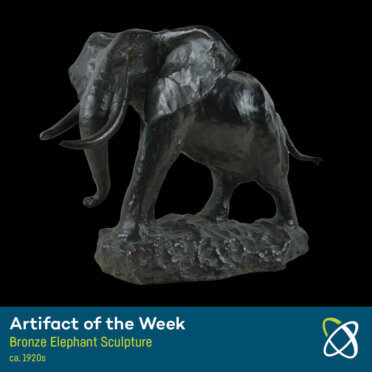Bronze Elephant Sculpture – ca. 1920s
Did you know that you can tell the three species of elephant apart by looking at their ears? It’s true! The ears of the African elephant species (Savanna and Forest) are much larger than their Asian elephant cousins. Also, the shape of African elephant ears looks like the African continent, while Asian elephant ears are more rounded at the top and shaped like the Indian subcontinent. Based on this information, this bronze sculpture depicts an African elephant.

Did you know that the process used to form bronze statues and sculptures was developed around 4500 BC? Called lost wax casting, this is a process where molten metal is poured into a mold and allowed to solidify.
First, a model of the sculpture is created in clay, plaster, or resin. Next, a mold of this sculpture is made, and wax is spread inside the two parts of the mold. Excess wax is removed, and the two parts of the mold are closed together. Liquid wax is poured inside to fill the empty spaces, and when the wax has hardened, the mold is opened leaving a wax model, or proof, behind. Finally, the bronze is poured into the mold and left to harden. The mold is carefully removed, and the bronze sculpture is cleaned and finished.
Why did artists choose to make sculptures out of bronze? Bronze allows the artist to achieve both consistency and detail during the casting process. Artists also value the rich coloring of the metal, and the distinctive patina that develops over time. And some molds can be reused after the first sculpture is made, meaning the artwork can easily be reproduced.
See more Artifacts of the Week
Artifact of the Month Video Series
Connect with curiosity!










